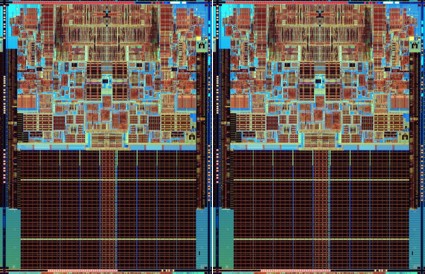Tom's Hardware's 2007 CPU Charts
E6000 Series Nomenclature
Core 2 Duo E6000 is the avant garde, featuring FSB1066 and now FSB1333 speeds (with model numbers ending with -50). The E6000 processors ending in -20 are similar to the versions ending in -00, but they have 4 MB L2 cache instead of 2 MB. The E4000 series was introduced for systems running at FSB800 speed; these processors carry only 2 MB L2 cache. Intel also revived the Pentium brand to fight AMD in the low end: with the entry-level dual cores Athlon 64 BE-2300 and BE-2350, or Athlon 64 X2 3800+ to 4200+ being very affordable, Intel positioned Core 2 by releasing the Pentium Dual Core processors E2160 and E2140. These have only 1 MB of shared L2 cache, but they still are very capable of taking on the AMD processors.
Conroe-based Celerons: Celeron D 420, 430, 440
| Celeron D 420 to 440 | |
|---|---|
| L2 Cache | 512 kB |
| Front Side Bus | 200 MHz (FSB800) |
The Celeron D 400 is now also based on the Core 2 microarchitecture. It only has one processing core, 512 kB L2 cache, and runs at FSB800 speed. The core clock speeds are 1.6, 1.8 and 2.8 GHz for the models 420, 430 and 440 respectively. All Celeron D processors are rated at only 35 W of Thermal Design Power (TDP), which makes them the most efficient Intel processors. They're not particularly fast, though, so you should consider these a good choice only for entry-level business PCs. The Celeron D 400 series does not support virtualization technology.
The Quad Core Trick: Two Dies On A Chip
Click to enlarge qx6700_die_big.jpg
I already mentioned this when I described what the Phenom X4 processor will look like, but the fact that today's Intel quad core processors are composed of two dual core chips has a double importance. On the one hand, this approach might have performance disadvantages at some point when compared to native quad core designs, because inter-chip communication has to take place over the Front Side Bus. Since the FSB has to be used to access the main memory as well, there is an obvious bottleneck here, though it remains to be seen whether this will ever be significant. It certainly has disadvantages when it comes to power requirements, because it's not possible to use only one of the two dies; both chips will remain active in power saving modes. Only a native design will be able to reach really low power requirement numbers. On the other hand, a dual die design is a huge tactical advantage and also has business benefits for Intel: it can adjust its manufacturing to put out as many dual core processors as possible, or respond to changing market demand in the direction of quad cores rather quickly.
Get Tom's Hardware's best news and in-depth reviews, straight to your inbox.
Current page: E6000 Series Nomenclature
Prev Page Intel: Core 2 Rules The Processor Arena Next Page New Core 2 Processors
Patrick Schmid was the editor-in-chief for Tom's Hardware from 2005 to 2006. He wrote numerous articles on a wide range of hardware topics, including storage, CPUs, and system builds.
